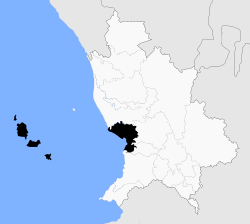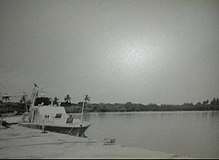San Blas, Nayarit
San Blas is both a municipality and municipal seat located on the Pacific coast of Mexico in Nayarit.
San Blas | |
|---|---|
Panorama of San Blas | |
 Location of San Blas municipality in Nayarit | |
 San Blas Location of San Blas in Mexico | |
| Coordinates: 21°32′23″N 105°17′8″W | |
| Country | Mexico |
| State | Nayarit |
| Founded | 1530 |
| Founded by | Nuño de Guzmán |
| Seat | San Blas |
| Government | |
| • Presidente municipal | Candy Anisoara Yescas Blancas ( |
| Area | |
| • Municipality | 823.6 km2 (318.0 sq mi) |
| Highest elevation | 30 m (100 ft) |
| Population | |
| • Municipality | 37,478 |
| • Density | 46/km2 (120/sq mi) |
| • Urban | 10,187 |
| Time zone | UTC-7 (MST (Zona Pacífico)) |
| • Summer (DST) | UTC-6 (MDT (Zona Pacífico)) |
| Postal Code | 63740 |
| Area Code | 323 |
| Website | sanblas |
City
San Blas is a port and popular tourist destination, located about 160 kilometres (99 mi) north of Puerto Vallarta, and 64 kilometres (40 mi) west of the state capital Tepic, and three hours drive from Guadalajara. The town has a population of 8,707.[1]
Municipality
The municipality had a population of 37,478 in 2005.[1] The Islas Marías, the site of an infamous prison colony, are part of the municipality.
History
In 1768, the Bourbon Visitador José de Gálvez decided to found the port of San Blas as a jumping off point for military expeditions to Sinaloa, Sonora, Baja California and Alta California.[2] The military nature of San Blas distinguished it from the commercial port of Acapulco to the south. A subtext to the founding of San Blas may have been Gálvez' desire to curtail tax evasion on trade with Asia out of Acapulco, which was controlled by businessmen of Mexico City.[3] Both Acapulco and San Blas tied New Spain to Asia through Manila. Gálvez also founded a shipyard in San Blas, with the next shipyard being Cavite in the Philippines. From 1774, navy ships delivered mail from San Blas to Manila. By tradition, the crew could carry private merchandise, so there was a small commercial subtext to San Blas from its inception [4] In the 1790s, the Bourbon monarchy approved special permits for private ships to sail from Cadiz to San Blas.[5] In 1801 and 1807, two ships of the Royal Philippine Company stopped in San Blas, though they were officially permitted only to sail to Lima.[6] It was not until crisis broke out in the Spanish Empire in 1810 that San Blas opened its ports to trade between Lima, Panama, San Blas, Guaymas, Monterey and Manila. Silver mined in Mexico's northwest was shipped out of San Blas to pay for imports of goods, particularly from Panama, which was flooded with British products that entered through Jamaica on the other side of the isthmus.
At first, only two ships were assigned to the port: the packet ship San Carlos, commanded by Juan Pérez, and El Principe, commanded by Vicente Vila. Gálvez ordered four new vessels to be built, one of which was the schooner Sonora, later sailed in 1775 by Juan Francisco de la Bodega y Quadra to Alaska.[7]
In many ways, San Blas was a poor choice for a deep sea harbor and settlement. The harbor was so small that it could never hold more than four ships at a time. Silting caused by the nearby Río Grande de Santiago resulted in the need for the harbor to be regularly dredged. The climate's stifling humidity and torrential rains from July to October, coupled with extensive mangrove swamps that surrounded the settlement, resulted in San Blas being plagued by clouds of voracious mosquitoes. A variety of sicknesses were endemic, including dysentery, typhoid fever, malaria, and other fevers.[7] Naval officers and workers regularly complained about the climate. When Alessandro Malaspina visited in 1791, he found San Blas's climate so unhealthy that he refused to stay there, instead transferring his operations and some of San Blas' ships and personnel to Acapulco. San Blas's location was useful and logical, however, because it minimized travel time from Guadalajara and Mexico City without increasing the total distance to the Californias. Also, the area around San Blas had a plentiful supply of hardwoods useful for ship building and repair. Fresh water was also available year round.[7]
A hillside fort was built in 1770 to defend the town's sea trade with the Philippines. Its front has stone carvings of the kings of Spain. On the hill behind the fort are the ruins of the Church of Our Lady of the Rosary, built in 1769. The ruins once contained the bronze bells that are said to have inspired Henry Wadsworth Longfellow's poem, "The Bells of San Blas". The ruins of a 19th-century customs house are on Calle Benito Juárez, three blocks from the main plaza.
During the colonial period, hardwood forests provided the raw materials for ships that did a brisk trade with the Philippines and the Manila galleon until the shipping moved to the port at Manzanillo, and later to Acapulco.
San Blas and California
Spain's colony in California was supplied by two supply ships out of San Blas which arrived once a year. on March 12, 1768 Junípero Serra, Father President of the California Missions, departed for California on the locally built barque Purísima Concepción.
On March 16, 1775, the San Carlos was set to depart San Blas, Mexico, for San Francisco Bay, stopping in Monterey to unload supplies for the mission there. The vessel was a product of the shipyard established on the Santiago River. Her length was 58 feet, the officers and men numbered 30.
San Blas and Nootka
San Blas also became the base for Spanish expeditions to the Pacific Northwest. The Chinese were willing to pay up to $120 per otter hide (about $2,700 in 2019 dollars) which stimulated exploration of the Northwestern Pacific. From 1789 to 1795, San Blas was responsible for establishing and maintaining the Spanish post at Nootka Sound and Fort San Miguel. For about twenty years in the late 18th century, San Blas was one of the busiest ports and shipbuilding centers on the Pacific coast of the Americas, rivaling Acapulco, the eastern terminus of the trans-Pacific Manila galleon convoy.[7]

At its height, the town had 30,000 inhabitants and became headquarters of Spain's General of the Southern Seas.
Yaqui deportations
During the 1900s, San Blas served as the arrival port for thousands of Yaqui men, women and children forcibly removed from their lands and sold into slavery.[8] At San Blas, these families were forcibly marched 200 miles to San Marcos and its train station.[8] Those who did not die on the march were sold into slavery at San Marcos, where they were deported to the sugar cane plantations in Oaxaca, the tobacco planters of the Valle Nacional, and the henequen plantation owners of the Yucatán for use as slave labor.[8] Most of the enslaved workers died within the first year of their captivity.[8]
Climate
| Climate data for San Blas | |||||||||||||
|---|---|---|---|---|---|---|---|---|---|---|---|---|---|
| Month | Jan | Feb | Mar | Apr | May | Jun | Jul | Aug | Sep | Oct | Nov | Dec | Year |
| Average high °C (°F) | 28.0 (82.4) |
28.2 (82.8) |
28.8 (83.8) |
30.2 (86.4) |
31.9 (89.4) |
33.3 (91.9) |
34 (93) |
34.1 (93.4) |
33.8 (92.8) |
33.8 (92.8) |
31.7 (89.1) |
29.0 (84.2) |
31.4 (88.5) |
| Daily mean °C (°F) | 22.1 (71.8) |
22.1 (71.8) |
22.5 (72.5) |
24 (75) |
26.3 (79.3) |
28.8 (83.8) |
29.3 (84.7) |
29.4 (84.9) |
29.2 (84.6) |
28.8 (83.8) |
26.2 (79.2) |
23.4 (74.1) |
26 (79) |
| Average low °C (°F) | 16 (61) |
15.9 (60.6) |
16.2 (61.2) |
18 (64) |
20.7 (69.3) |
24.3 (75.7) |
24.7 (76.5) |
24.8 (76.6) |
24.7 (76.5) |
24 (75) |
20.6 (69.1) |
18 (64) |
20.6 (69.1) |
| Average precipitation mm (inches) | 20 (0.8) |
13 (0.5) |
5.1 (0.2) |
0 (0) |
20 (0.8) |
130 (5.1) |
340 (13.3) |
390 (15.4) |
360 (14.2) |
120 (4.9) |
13 (0.5) |
23 (0.9) |
1,440 (56.8) |
| Source: Weatherbase [9] | |||||||||||||
Recreation and tourism
The area is noted for its surfing. Playa de Matanchen was famous for having the longest surfable wave in the world, as listed in the Guinness Book of World Records. A hurricane and subsequent storm surge filled part of the bay with sand, greatly reducing the size of the waves.
The area has an abundance of migratory birds in the surrounding estuaries and lowland palm forests, attracting significant numbers of birders. The Christmas Bird Count regularly finds well over 200 species, with a record 292 species in 1983.[10]
The town is also a gateway, along with the nearby village of Matanchen, to the La Tovara park, an extensive mangrove forest and federally protected nature preserve accessible by small boat.
The formerly elegant Playa Hermosa, built in 1951, is on a lonely and beautiful stretch of beach about a mile from the plaza. In the 1960s, Hollywood had a brief hideaway flirtation with San Blas when actors, including Lee Marvin, discovered San Blas for its fishing. The hotel is now abandoned.
Economy
The economy is based on agriculture, fishing, and the tourist industry. The main crops are beans, sorghum, tobacco, corn, watermelon, and citrus fruits. There is a substantial cattle herd, and shrimp are raised in the extensive marshlands.
References
- "Enciclopedia de los Municipios de México: Nayarit". Archived from the original on 2007-09-30. Retrieved 2007-12-02.
- Priestley, Herbert Ingram. 1916. José de Gálvez: Visitor General of New Spain (1765-1771). Berkeley: University of California.
- Trejo Barrajas, Dení, and Marie Christine Duggan. 2018. “San Blas and the Californias: Hispanic Trade in the Northern Pacific Rim in a Time of Great Change” in Mains’l Haul, San Diego Museum of Maritime History.
- Pardo Hernández, Claudia Patricia (1994). San Blas y su relación con Filipinas, 1790-1820. Trabajo de licenciatura en historia. Iztapalapa: Universidad Autonoma Metropolitana.
- Trejo Barajas, Dení. 2006. “Implicaciones del comercio por el puerto de San Blas durante la guerra de Independencia,” Revista de Indias 66: 711-736.
- Valdés Lakowsky, Vera. 1987. De las Minas al Mar: Historia de la Plata Mexicana en Asia 1565-1934. Mexico: Fondo de Cultura Económica.
- Tovell, Freeman M. (2008). At the Far Reaches of Empire: The Life of Juan Francisco De La Bodega Y Quadra. University of British Columbia Press. pp. 163–166. ISBN 978-0-7748-1367-9.
- Turner, John Kenneth, Barbarous Mexico, Chicago: C.H. Kerr & Co., 1910, pp. 41–77
- "Weatherbase: Historical Weather for San Blas, Nayarit". Weatherbase. 2011. Retrieved on November 24, 2011.
- "Historical data for CBC Count Circle Code MXSB". Retrieved 2010-02-12.
External links
| Wikimedia Commons has media related to San Blas, Nayarit. |
- Government tourism page
- The Naval Department of San Blas, Spain's Supply and Shipbuilding Center for Alta California and the Pacific Northwest, 1770–1810
